Sigma Xi 2018 Student Research Showcase
Ecology & Evolutionary Biology

The Impact of Railways on Gopher Tortoises
Rhett Rautsaw, Clemson University
Roads are known to impact wildlife, but what about railways? In this study, we wanted to find out how railways impact tortoise movement and behavior. We use radio-telemetry, behavioral trials, and game cameras to assess this problem and help find a solution.
 Training Citizen Scientists to Collect Ecological Data
Training Citizen Scientists to Collect Ecological Data
Margaret Gaddis, University of the Rockies
I present my dissertation research. The purpose of this qualitative comparative multiple case study is to identify patterns and themes in content, instructional design, theoretical alignment, and perceived efficacy of training for citizen scientists tasked with collecting ecological data in the field.
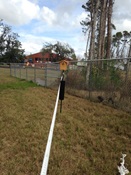 Nest-box Visibility Impacts Songbird Reproductive Success
Nest-box Visibility Impacts Songbird Reproductive Success
Brittany Bailey and Kaitlyn Zielger, Islands High School
The visibility of a nest is a crucial factor in the number of eggs per nest and the survivability of songbirds. The visibility of a nest-box can influence whether birds select that location for their reproductive event. Greater visibility can lead to increased predation and exposure to inclement weather. In this study, we observed Eastern Bluebirds (Sialia sialis) and Carolina Chickadees (Poecile carolinensis) in Savannah, Georgia.
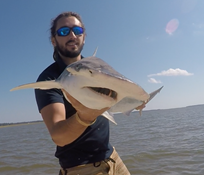
Assessing the Role of Magnetic-based Navigation in the Spatial Ecology of the Bonnethead, Sphyrna tiburo
Bryan Keller, Florida State University
The presentation will address our methods for assessing the role of magnetic-based navigation in the spatial ecology of the bonnethead shark. The audience will also be provided with our hypotheses, findings, objectives and the broader impacts of the work.
 Anthropogenic Noise Impacts Reproductive Success in Songbirds in Savannah, Georgia
Anthropogenic Noise Impacts Reproductive Success in Songbirds in Savannah, Georgia
Carlee Skarin, Islands High School
Anthropogenic noise can interrupt essential songbird communication and possibly cause damage to embryos and nestlings. Anthropogenic noise negatively impacts the bird’s ability to make calls for mating and reproduction, foraging, and alerting about predation. We recorded anthropogenic noise at various breeding sites using the Decibel 10th application on an iPhone 6.
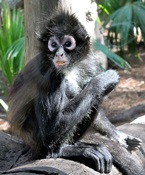 The Evolution of Spider Monkey Color Vision
The Evolution of Spider Monkey Color Vision
Cassie Vergason, Florida Institute of Technology
Match-to-sample paradigms have been used for many years to explore learned association and memory in animal species. Frequently, this is done either in an operant conditioning chamber or on a computer. Both methods rely on using two-dimensional visual stimuli. However, relatively little work has been done with match-to-sample paradigms with physical objects. We are interested in whether spider monkeys (Ateles geoffroyi; n=4) can learn a three-dimensional match-to-sample paradigm.
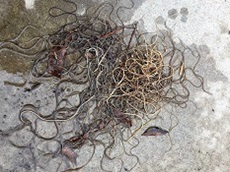
Field and Experiemntal Observations on a New Gordius sp. (Nematomorpha: Gordiia) with the First Documented Terrestrial Life Cycle for the Phylum
Christina Anaya, Oklahoma State University
All gordiids have complex life cycles and are considered aquatic in their free-living phase. However, recently we discovered a new Gordius sp. in Oklahoma which occurs in terrestrial habitats. My goal was to investigate the transmission aspects of Gordius robustus in Oklahoma.
 Nest-box Visibility Impacts Songbird Reproductive Success
Nest-box Visibility Impacts Songbird Reproductive Success
Brittany Bailey and Kaitlyn Zielger, Islands High School
The visibility of a nest is a crucial factor in the number of eggs per nest and the survivability of songbirds. The visibility of a nest-box can influence whether birds select that location for their reproductive event. Greater visibility can lead to increased predation and exposure to inclement weather. In this study, we observed Eastern Bluebirds (Sialia sialis) and Carolina Chickadees (Poecile carolinensis) in Savannah, Georgia.

Assessing the Role of Magnetic-based Navigation in the Spatial Ecology of the Bonnethead, Sphyrna tiburo
Bryan Keller, Florida State University
The presentation will address our methods for assessing the role of magnetic-based navigation in the spatial ecology of the bonnethead shark. The audience will also be provided with our hypotheses, findings, objectives and the broader impacts of the work.
 Anthropogenic Noise Impacts Reproductive Success in Songbirds in Savannah, Georgia
Anthropogenic Noise Impacts Reproductive Success in Songbirds in Savannah, Georgia
Carlee Skarin, Islands High School
Anthropogenic noise can interrupt essential songbird communication and possibly cause damage to embryos and nestlings. Anthropogenic noise negatively impacts the bird’s ability to make calls for mating and reproduction, foraging, and alerting about predation. We recorded anthropogenic noise at various breeding sites using the Decibel 10th application on an iPhone 6.
 The Evolution of Spider Monkey Color Vision
The Evolution of Spider Monkey Color Vision
Cassie Vergason, Florida Institute of Technology
Match-to-sample paradigms have been used for many years to explore learned association and memory in animal species. Frequently, this is done either in an operant conditioning chamber or on a computer. Both methods rely on using two-dimensional visual stimuli. However, relatively little work has been done with match-to-sample paradigms with physical objects. We are interested in whether spider monkeys (Ateles geoffroyi; n=4) can learn a three-dimensional match-to-sample paradigm.

Field and Experiemntal Observations on a New Gordius sp. (Nematomorpha: Gordiia) with the First Documented Terrestrial Life Cycle for the Phylum
Christina Anaya, Oklahoma State University
All gordiids have complex life cycles and are considered aquatic in their free-living phase. However, recently we discovered a new Gordius sp. in Oklahoma which occurs in terrestrial habitats. My goal was to investigate the transmission aspects of Gordius robustus in Oklahoma.
 Nest-box Visibility Impacts Songbird Reproductive Success
Nest-box Visibility Impacts Songbird Reproductive Success
Brittany Bailey and Kaitlyn Zielger, Islands High School
The visibility of a nest is a crucial factor in the number of eggs per nest and the survivability of songbirds. The visibility of a nest-box can influence whether birds select that location for their reproductive event. Greater visibility can lead to increased predation and exposure to inclement weather. In this study, we observed Eastern Bluebirds (Sialia sialis) and Carolina Chickadees (Poecile carolinensis) in Savannah, Georgia.

Assessing the Role of Magnetic-based Navigation in the Spatial Ecology of the Bonnethead, Sphyrna tiburo
Bryan Keller, Florida State University
The presentation will address our methods for assessing the role of magnetic-based navigation in the spatial ecology of the bonnethead shark. The audience will also be provided with our hypotheses, findings, objectives and the broader impacts of the work.
 Hive Minded: Like Neurons, Honeybees Collectively Integrate Stop Signals to Regulate Forager Recruitment
Hive Minded: Like Neurons, Honeybees Collectively Integrate Stop Signals to Regulate Forager Recruitment
Talia Borofsky, Swarthmore College
Honeybees have a dance language. Many people know of the waggle dance, in which a bee dances in a figure-8 to recruit other hivemembers to a foraging site or a potential new home. But have you heard of the stop signal? I have been studying how dynamics resulting from the stop signal can regulate foraging, and whether these dynamics can be modeled using equations from theoretical neuroscience.
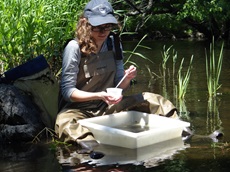 Evolution of North American Micruracarus Water Mites
Evolution of North American Micruracarus Water Mites
Rachel Shoop, San Diego State University
There are over 6,000 described species of water mites across the world, but, unfortunately, we know very little about them. My research focuses on the evolution of one subgenus of fresh water mites in North America with a complicated taxonomic history. This research utilizes advanced molecular methods to resolve species relationships and tests the reliability of morphological characters commonly used to identify species.
 The Evolution of Egg Size in Substrate Spawning Cichlid Fishes
The Evolution of Egg Size in Substrate Spawning Cichlid Fishes
Summer DeRobertis, California State University, Sacramento
Our research attempts to answer the question: is there a benefit to having large eggs despite the possible costs of making fewer of them? To examine this, we bred cichlids in the laboratory, sampled their eggs and fry, and compared the size of the two.